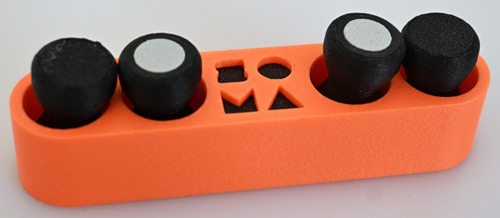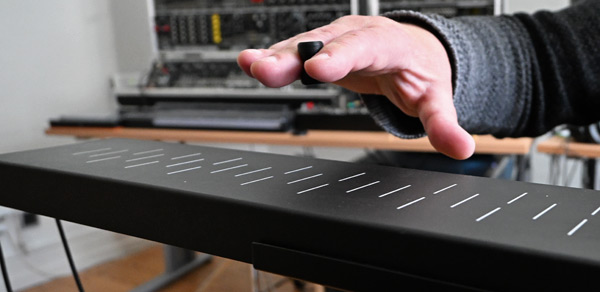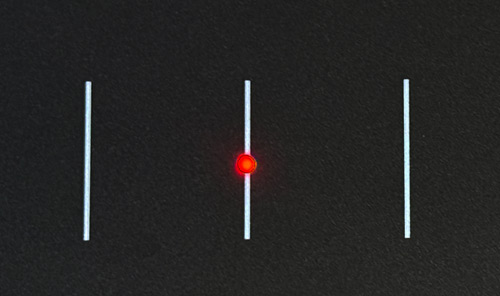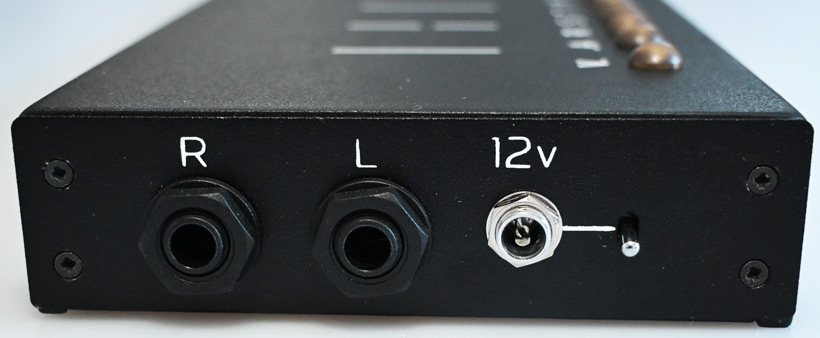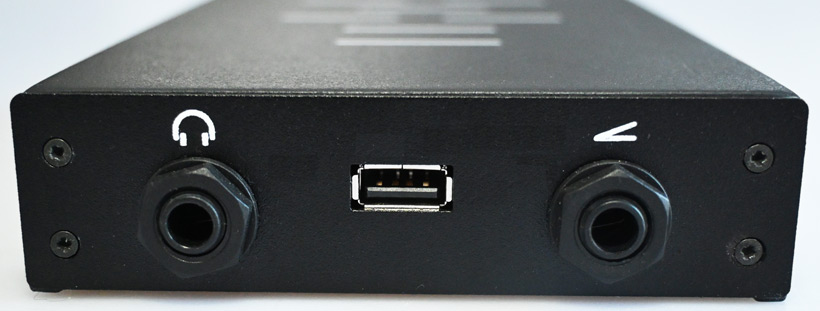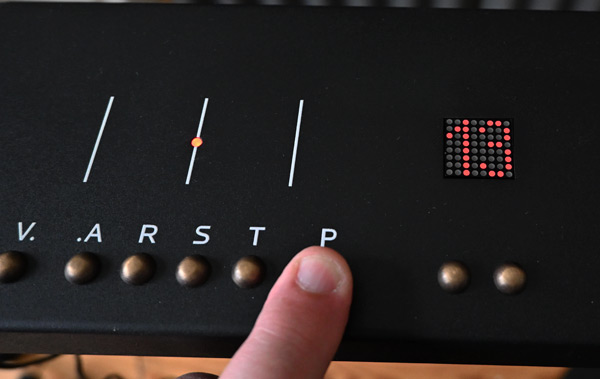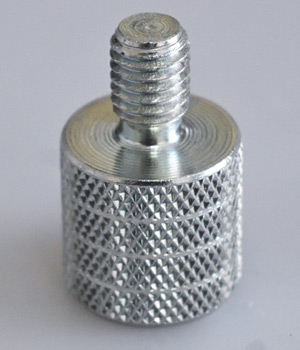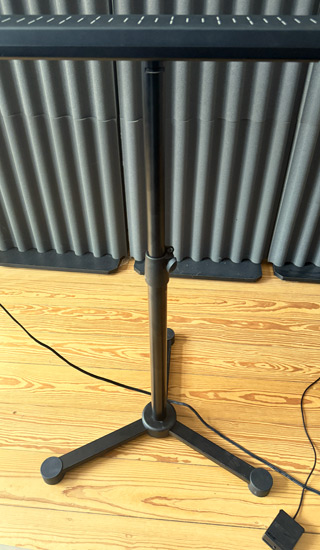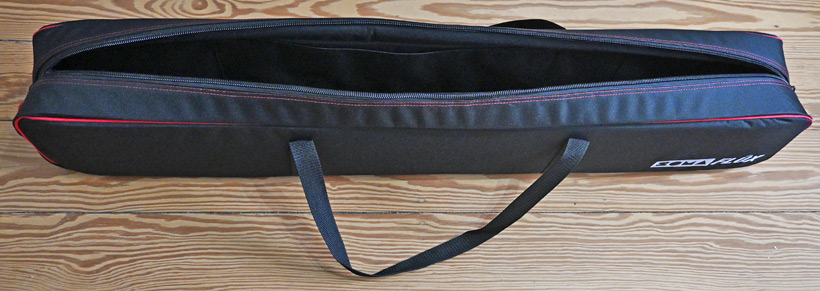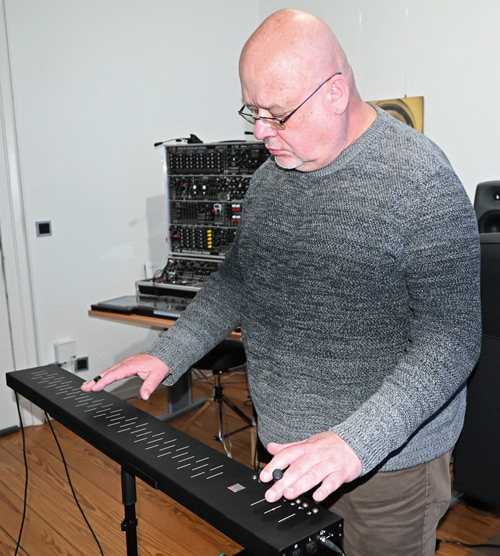SOMA Flux
An expressive musical instrument of a different kind
Author and photos: Peter Kaminski and archive (1)
Besides reviewing tools for professional audio production and playback, we also feature particularly interesting musical instruments and MIDI controllers. The Flux from SOMA, which was announced a year ago and has been available since May 2025, definitely falls into our categories. Flux offers a new approach to playing and controlling pitch, volume, and modulation.
Inspiration: the theremin
Let's first take a look at the instrument that inspired the Flux, namely the theremin, which was one of the first electronic musical instruments. It was introduced in 1920 and invented by Russian Lew Termen, who called himself Leon Theremin internationally. The theremin went through many changes over the decades. The first models were still built with tubes. Bob Moog had already been working with the theremin before the first synthesizers were developed and offered several different theremin products, including some with transistor circuits. Even today, the manufacturer Moog still has theremin products in its product range. There are also a number of orchestral compositions for theremin, both in the classical and contemporary music genres.
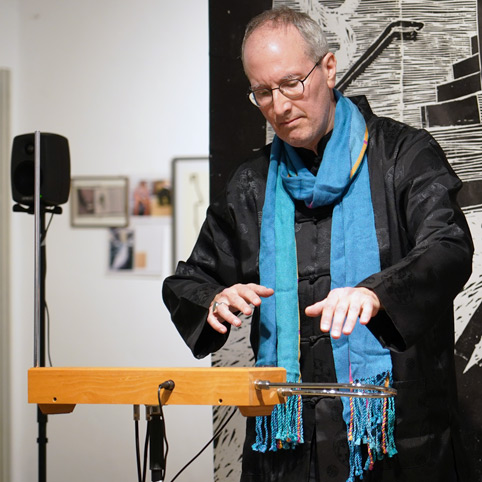
Andrew Levine with a theremin | © Julia Hansjosten
The theremin is played without touching the instrument. The right hand controls the pitch by changing the distance, while the left hand controls the volume. The sound has also changed over time. In the beginning, it was a pure sine tone - but later, several oscillators were used to make the sound richer in overtones. The control principle for the pitch is based on a high-frequency oscillator connected to an antenna. The frequency of such an oscillator is determined by a coil and a capacitor that form an oscillating circuit. When the hand approaches the instrument, additional capacitance is introduced into the oscillating circuit, causing it to detune. This well-known effect from high-frequency technology is also known as "hand capacitance".
It is very difficult to accurately match the pitch by adjusting the distance to the antenna. The environment also has an influence, and the sensitivity, or the change in pitch in relation to the distance, is not linear and also varies from product type to product type. Over the course of the development of playing the theremin, a certain playing technique has been developed. Instead of controlling the pitch solely with the distance, this is done using certain hand gestures. Nevertheless, playing the theremin is a great challenge. In some newer theremins, quantization can therefore also be activated.
Flux concept
SOMA also has a lot of experience with interesting sound engine concepts. They have proven this not only with the Terra synthesizer. The internal DSP-based sound engine of the Flux currently offers 32 different synthesizer algorithms, each with up to eight variations. These variations include minor changes in sound or behavior. Presets can be stored both internally and externally. These presets contain the selected algorithm and variation, as well as all other parameters set on the Flux.
The Flux is exactly 1,000mm wide, 114mm deep, and 30mm high, weighing approximately 1.7kg. The biggest similarity between the Flux and the Theremin is that it is also played without contact. In other respects, however, the playing technique differs significantly. Instead of a high-frequency oscillator and hand capacitance control, the Flux uses a much more modern concept, namely sensors that react to magnetic fields and magnets that are held and moved in the hand. This allows for much more precise control of the instrument.
The positions of the semitones are marked on the surface of the instrument, with a single line symbolizing the white keys and a double line representing the black keys of a keyboard. The top of the image shows one octave. There are 37 semitones, i.e., three octaves of range, marked. The magnets should be moved by the player above the virtual center line, i.e., in the area between the double lines.
Four magnets are included in the scope of delivery of the Flux. The gray side normally faces downward, i.e., toward the Flux playing surface.
Playing technique
There are two areas on the Flux surface: on the right is the area for triggering the tones and controlling the pitch and volume, and on the left is the area for the various modulation options.
SOMA recommends holding the magnets with or between the index and middle fingers (see illustration above).
This has the advantage that by clenching the hand, the magnet now points with the other pole of the magnet toward the playing surface. This provides an alternative function. On the right, depending on the selected algorithm, you can trigger notes with a defined octave interval and thus easily change to a different pitch, for example, from a melody in high pitches to a bass sequence. Some algorithms also offer a modulation option by tilting the magnet more or less over the playing surface.
There are also different modes for playing. In addition to the normal mode, in which one voice is active, there is also a duophonic mode for playing with two magnets simultaneously, as well as a polyphonic mode in which the maximum number of voices can be set. This also depends on the selected algorithm.
The modulation field is located on the left. Depending on the selected algorithm, there is either a large area over which the magnet can be moved in all three dimensions to produce modulation, or the modulation range is divided into three lines, which are also marked with white lines on the field. In this case, three parameters can be adjusted in two dimensions (position and distance). Actually, it sounds more complicated than it actually is.
Connections
The connections for the Flux are located on both sides. On the left side are the two 6.3mm jack sockets for the audio outputs (18 V pp) and the socket (for 2.1mm hollow plugs with positive pole in the middle) for the supplied power supply unit with a 12-volt operating voltage (0.4 ampere operating current). Next to the socket is the switch for turning the Flux on and off.
On the other side is a stereo headphone output to which headphones with an impedance of 6 to 64 ohms can be connected. A foot switch can also be connected via another 6.3mm jack socket. The switch polarity is automatically detected when the device is switched on. There is also a USB-A socket for connecting a USB stick to transfer presets and update the Flux firmware.
Operation
The parameters are operated and selected on the left side using capacitive virtual buttons. After touching a button for a parameter setting, you can select the value with the magnet over the playing surface. When you remove your finger from the button, the value is saved. You can set an alternative value by turning the magnet over. There are also functions that require you to touch two buttons. The set value is shown on the display. These are usually numbers, graphics, or symbols. Presets can be saved both internally and externally. These presets contain the selected algorithm, along with its selected variation, and all other parameters set for the Flux.
Let's take a look at the functions of the six buttons below the modulation field. For example, the “V.” button can be used to set the analog output level and, with the magnet turned over, the internal digital level. For the analog level, a graphic symbolizing the level is displayed in the 64-point LED field - and for the digital level, a number from 00 to 99 is displayed. The “.A” button selects the algorithm and, when the magnet is turned, the variation of the algorithm. The “R” button sets the decay time for normal and percussive decay. The “S” button is for setting the effects. Currently, an echo or reverb algorithm can be selected using the “S” + “T” button combination. The “S” button is used to set the effect mix level and, with the magnet turned over, the echo or reverb time. The “T” button is used to set the octave position for normal play and, with the magnet turned over, the octave for reverse play. The “P” button and the magnet can be used to select and load one of the 37 possible presets. To save, press “P,” select the save number, and press the “A” or “V” button, whereby the latter also saves the output level. With the magnet turned upside down, the “P” button can also be used to set the number of voices for polyphony.
By pressing the connected foot switch and the “P” and “T” buttons, you can activate or switch the pedal function for the left side (modulation area) or the right side (playing area). Activating the left side maintains the modulation setting as long as the foot switch is held down, even if the magnet is not above the modulation area - in other words, the modulation state remains frozen as long as the foot switch is pressed. If this function is activated on the playing surface, you can switch between normal playing mode and percussive mode, switching to the other mode each time.
There are two unlabeled buttons below the display. The left button selects and sets the percussion mode, while the right button is for activating or deactivating a quantization. Pressing both buttons activates - or deactivates - the duophonic mode.
Algorithms
The 32 algorithms in firmware version 1.2 are surprisingly different. Each algorithm offers different modulation options, a number of variations, and a maximum number of voices. There is a separate manual for the algorithms, where each algorithm is described in detail on one page. Playing tips and suggestions can also be found here.
Here is an overview of the algorithms ...
- VOX is the classic theremin sound, which can be made more flexible using the modulation options and also allows for more powerful sound settings.
- PIPE is a physical model of an organ pipe with a relatively high noise content. With this algorithm, the volume is controlled more by the left hand through modulation. This is also the case with some other algorithms.
- DETUNE is an algorithm with detuned oscillators, whose detuning can be modulated very well with the left hand. A tilt over the playing surface allows you to influence the intensity and time of the effect.
- 3 POLES is a synthesis algorithm based on FM with a bandpass filter and detuned sawtooth waveforms that is also very reminiscent of a theremin, but offers very powerful modulation possibilities.
- DETUNED SAWS are multiple triangle/sawtooth oscillators with detuning capabilities and a downstream filter (low-pass or bandpass). Also a very theremin-like sound.
- BYTEBEAT is a rhythmic sound. In the BYTEBEAT TEMPO algorithm, you can also precisely control the rhythmic speed of the rhythmic pulsation.
Then, there are four different TREMOLO algorithms that sound like a plucked string instrument with tremolo, whereby the tremolo can also be changed dynamically. - BELL is a bell synthesis algorithm that can be made both very soft and extremely hard thanks to the modulation possibilities.
- 3D consists of four different algorithms that can be played particularly well using the modulation options. 3D 1 is more melodic and 3D 2 can also sound very screechy, depending on the modulation index. 3D 3 is based on triangle/sawtooth waveforms and 3D 4 has a noise component.
- 8BIT is a low-fi sound with great modulation possibilities for a hard sound.
- SYNC RESONANCES is a special type of synthesis with synchronized resonances.
- CLAVIER sounds like a piano when you set short decay times and otherwise more like a theremin.
- DIGITAL CHAOS is an algorithm with a ring modulator, more for experimental music.
- DELAYED PITCH is an algorithm with two oscillators, one of which delays its pitch, creating beats. This is particularly interesting for glissando playing.
- SOLO 1 is a lead sound based on wavetables.
- SOLO VOICE is a formant synthesis for replicating the human voice, particularly interesting for the possibilities of flux in terms of formant modulation and glissando playing.
- X PLECTRUM is a virtual string instrument in which the left magnet in the modulation field simulates a pick for virtual plucking. Playing requires some practice.
- CHORDS is an algorithm with various chords that can be triggered using the modulation field.
- DISSONANT HARMONIX offers highly atonal FM synthesis.
- RING MODULATOR offers lots of modulation options for players who like to experiment.
- BASS 1 is an algorithm that delivers exactly what it promises, with square or sawtooth waveforms and modulation options for the second harmonic and the downstream filter.
- PAN is an algorithm that allows you to influence the stereo panorama using the modulation option.
- DUO is particularly suitable for duophone playing, i.e., triggering a note with two magnets simultaneously.
- WAVETABLE-based algorithm with special possibilities to control the wavetable via the modulation range.
- SIX POLE is an algorithm with six different synthesizer sounds, the mixing ratio of which can be changed via the modulation range.
Most algorithms use the entire modulation area for modulation control, while a few use the three lines for three different modulation parameters.
Setup and transport
For mounting on a stand, SOMA offers the optional “Flux Speaker Stand Adapter” for the Flux. The Flux is placed on the adapter and is not attached. It can therefore slide to the side if bumped. We recommend a natural rubber THERABAND, which is also available in a suitable width of 127mm. This band must be cut to a length of approx. 425mm using long, sharp scissors. The cut piece is then simply placed on the adapter, preventing it from slipping. The band is available online, in medical supply stores, and in sporting goods stores.
It is designed to be mounted on a speaker stand with an 8mm thread. SOMA recommends a specific stand on its website, but this is not easy to find anywhere. We have therefore tried out a few alternatives and have some suggestions for you.
With the 21918 adapter from König & Meyer (see image above), the Flux Speaker Stand Adapter can also be attached to a microphone stand with a 3/8-inch threaded screw. The M8 screw thread (see image above) is 30mm long and, as the screw protrudes into the adapter and hits the Flux, you will need to use a few washers from a hardware store, place them on the adapter, and also obtain an M8 nut for fastening.
We tested it as described on the König & Meyer 26000 tripod with a large, heavy cast base (see fig. above). This works well - even during operation - as the capacitive buttons do not exert any significant mechanical pressure on the Flux. Lighter tripods can also be used for mobile applications, such as the 19900 from König & Meyer.
However, it is simpler and more stable to use a robust speaker stand with an 8mm screw, such as the König & Meyer 26720. No DIY work is required - and everything fits perfectly. The better fastening and thicker tube make the whole setup much more stable, making it highly recommended for studio use.
We also took a look at the bag for the Flux offered by SOMA. The Flux fits well and securely into the bag, which also has plenty of room for accessories. A small stand can also be stored in the bag for mobile use. SOMA also offers a flight case for even safer protection of the instrument.
Practical experience
We had the opportunity to test a Flux with firmware 1.3 extensively for several weeks. The first thing to note is that you should use low-impedance headphones - which is usually the case with modern headphones. The volume via headphones connected to the Flux is definitely loud enough. However, it cannot be controlled separately, but via the parameter for the analog output level. The Flux is very well made. It would have been nice if there would had been threads in the base of the housing for screwing it to the adapter. But we have described how best to set up the Flux.
You should use a USB flash drive with a small capacity with the Flux. When attempting to update via USB flash drive, it became apparent that USB flash drives with larger capacities do not work. We then tried an 8GB flash drive, and they worked perfectly. There is also a note about this in the manual.
The Flux is a completely new instrument, and like any instrument, you have to familiarize yourself with it and practice in order to achieve a certain level of perfection. The big advantage I see is that you can play your first phrases very quickly, unlike other instruments that you have to learn from scratch. After just a few minutes, you're already getting the hang of it. The intervals between the semitones are large enough to hit the desired note easily and precisely.
Different playing styles are always controversial. People always say you have to do it this way or that way, otherwise it's wrong. And then there are famous and successful guitarists who play exactly the way the experts say is wrong. Ultimately, playing styles are always a very individual matter. With a new instrument like the Flux, some things will have to evolve over time. The suggested hand position between the index and middle fingers is definitely practical and makes sense. However, if you don't want to or can't use the magnet rotation, holding the magnet between your thumb and index finger is also an alternative, as I have found that this allows you to control the pitch and modulation a little more precisely. I personally feel that this gives me even better control, especially when playing slides.
Unlike the theremin, the SOMA Flux is relatively resistant to external influences in practice. After switching on, it calibrates itself automatically, even unnoticed in between. Manual calibration is also possible, but we never had to activate it during the test period. The instrument can be played immediately after switching on. The reproduction of the controls is very accurate. Just make sure not to place headphones with internal permanent magnets on the playing surface.
I also really like the optional quantization feature, which allows you to adjust the quantization strength. However, after a short time, I stopped using the quantization so that I could also play glissando passages. This is one aspect that makes the instrument so interesting. It is also important to know that in duophonic mode, you have to play duophone with both magnets simultaneously or synchronously over the playing area, otherwise there will be unwanted sound effects. However, this is not a problem, as you can quickly switch between monophonic and duophonic modes by selecting the two virtual buttons below the display.
The modulation possibilities via the lateral rotation (tilt) of the magnet take some time to get used to. The problem here is that when playing with quantization switched off, this movement can easily distort the pitch. The left modulation surface is a big challenge when playing, especially when the modulation field is divided into three segments in some algorithms. Controlling the modulations is very sensitive, and you have to handle the magnet very carefully to avoid causing extreme modulations. When divided into three segments, it is easy to slip into the neighboring segment if you lose concentration. Modulation therefore requires some learning and practice.
When I first read the manual without having the Flux in front of me, I found the controls very complicated. But when you try out the first few steps on the instrument, you realize that it's actually easier to use than you thought. Nevertheless, there are things that take some time to get used to, such as pressing the “S” button first and then the “T” button when changing the effect algorithm, rather than pressing them simultaneously. Furthermore, it is difficult at first to remember all the symbols for the different algorithms and then assign or recognize them on the display. Numbering the algorithms might have been helpful here, rather than using symbols alone. It also takes a lot of experience to remember all the different modulation options and variations of the algorithms. At the beginning, you should limit yourself to a few algorithms, such as VOX and SOLO VOX.
Conceptually, the synthesizer engine in the Flux does not offer many sound-determining parameters in a preset besides the algorithm, variation, and modes, as the focus is on parameter modulation. However, you can change the release times. It's worth playing around with this, as it allows you to create some very interesting ambient sounds. Interesting sounds can also be created in combination with the SOMA COSMOS - an ideal effects device for the Flux.
When switching between presets, you should wait until the sound has faded out - otherwise, you will produce unwanted noise when switching. When freezing the modulation setting with the footswitch, please note the following: When releasing the footswitch, you should try to return to a similar magnetic position as when freezing - otherwise, the modulation will suddenly change to the neutral position. Once you have learned this, you will be able to use it effectively. These are all things that you just have to learn. Freezing the modulation with the footswitch is very helpful, especially for longer passages that you want to play with the same modulation. Switching between normal and percussive modes with the footswitch also enhances the expressive possibilities of the instrument.
By the way, if you're interested in a short video presentation, we can recommend the SOMA FLux video from Prolight + Sound 2025, which we recorded with Tim Kroker.
Since November 2025, a breakout box for the Flux is available, which turns the instrument into a MIDI and CV controller. More about the Flux Breakout Box in a separate review.
Conclusion
The price for the SOMA Flux is around 1,700 € or US$, which is absolutely reasonable. The carrying bag is available for around 100 euros, and the flight case from SOMA for the Flux is around 430 euros. It's great that someone has come up with the idea of developing a truly new instrument. The Flux is really fun and opens up new musical possibilities that are not possible with other electronic instruments – not even with the Theremin. With Flux, you have more control over the sound than with a classic keyboard via velocity, wheels, and, if applicable, aftertouch. The Flux offers the possibility of controlling a variety of parameters simultaneously with both hands or with magnets guided by the hands. The internal DSP sound engine is also optimized for the possibilities offered by the Flux in terms of playing style with the algorithms and resulting sounds it offers.
The SOMA Flux is simply a great instrument with enormous potential for future development. When the optional breakout box becomes available, we will definitely publish a second part of our test, as Flux will then certainly be well positioned as a pure controller. Since the end of 2025, Flux has also been available in other colors: white, pink, blue, and orange.
 How to resolve AdBlock issue?
How to resolve AdBlock issue? 

